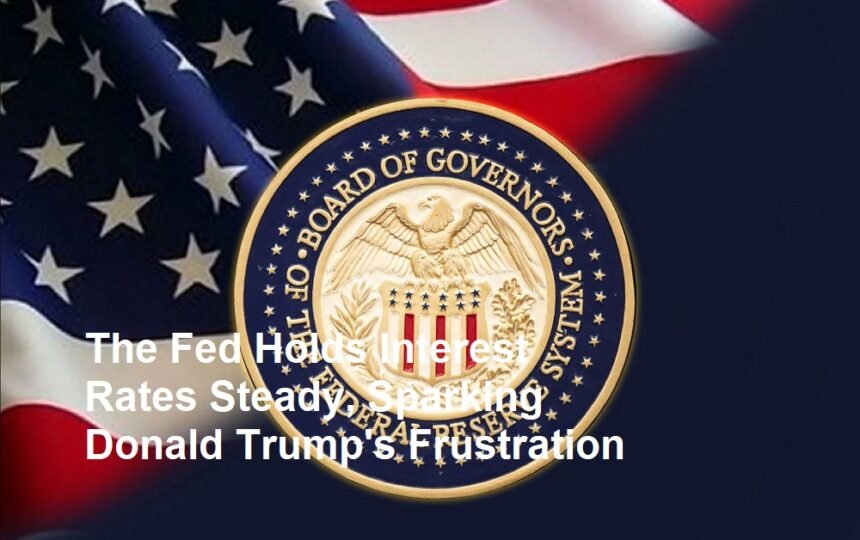Washington, D.C. – January 2025 – The U.S. Federal Reserve (The Fed) has decided to maintain its benchmark interest rate, a move that has drawn strong criticism from former President Donald Trump. The central bank’s decision to keep rates unchanged comes amid ongoing debates over inflation, economic stability, and the upcoming 2024 presidential election’s impact on financial policies.
The Fed’s Decision: Stability Over Change
At its January 2025 policy meeting, the Federal Reserve announced that it would hold the federal funds rate at 5.25% – 5.50%, the highest level in over two decades. The decision follows a series of rate hikes implemented throughout 2022 and 2023 to combat rising inflation.
In its statement, the Federal Open Market Committee (FOMC) justified the move by citing moderating inflation trends and solid but slowing economic growth.
“While inflation has eased over the past year, it remains above our 2% target. Given the current economic conditions, we believe it is appropriate to maintain the current rate level,” said Fed Chair Jerome Powell in a press conference.
The Fed’s stance signals a cautious approach, ensuring that inflation continues to decline without triggering a recession. However, this policy has been met with political backlash, particularly from Donald Trump.
Donald Trump Reacts: “A Disastrous Mistake!”
Shortly after the Fed’s announcement, Donald Trump, the Republican frontrunner for the 2024 U.S. presidential election, took to social media to express his frustration.
“The Fed is making a DISASTROUS mistake by keeping rates so high! They are destroying the American economy and hurting businesses. This is Biden’s fault, and it must change!” Trump wrote on his Truth Social platform.
Trump has been a longtime critic of the Federal Reserve, frequently clashing with the institution during his presidency (2017-2021). His frustration stems from the belief that higher interest rates hurt businesses, homebuyers, and stock markets, slowing economic momentum.
His criticism is also seen as part of his broader campaign strategy to attack President Joe Biden’s economic policies, blaming the administration for sluggish economic growth and financial struggles faced by American citizens.
Economic Implications: What’s Next for Interest Rates?
The Fed’s decision is expected to have mixed effects on the economy:
- Impact on Borrowers and Businesses
- High borrowing costs remain: The steady interest rates mean continued higher mortgage rates, car loans, and credit card debt.
- Business investments may slow: Small and medium-sized enterprises (SMEs) may delay expansion plans due to expensive financing.
- Stock Market Reaction
- Markets initially reacted with caution, with the Dow Jones Industrial Average dropping 0.8% and the Nasdaq falling 1.2% after the announcement.
- Tech and real estate stocks were particularly affected, as these sectors are sensitive to interest rate policies.
- Inflation and Consumer Spending
- Inflation has fallen from its 9.1% peak in mid-2022 to around 3.4% in January 2025, but remains above the Fed’s 2% target.
- Consumers may continue to cut spending, which could slow economic growth in the coming months.
Some analysts believe that the Fed may begin cutting rates later in 2025, especially if inflation continues to decline.
Political Ramifications: Trump vs. The Fed
The clash between Trump and the Federal Reserve highlights how economic policies are becoming central to the 2024 U.S. presidential election.
Trump’s Perspective
- The former president argues that high interest rates are hurting the economy and creating unnecessary financial burdens.
- He has previously hinted that if re-elected, he would push for lower interest rates and potentially fire Jerome Powell, whom he originally appointed as Fed Chair in 2018.
Biden’s Position
- The Biden administration has supported the Fed’s independence, avoiding direct intervention in its monetary policy decisions.
- Treasury Secretary Janet Yellen defended the Fed’s stance, stating that lowering rates too soon could reignite inflation and cause long-term instability.
With only 10 months left before the 2024 election, economic performance will likely play a major role in shaping voter sentiment.
Conclusion: Uncertainty Ahead
The Federal Reserve’s decision to hold interest rates steady has triggered political and economic debates across the U.S. Donald Trump’s frustration reflects growing concerns over economic growth, inflation control, and election-year policies.
As the 2024 presidential race intensifies, the Fed’s future actions will be closely monitored. The question remains: Will the Fed cut rates later in 2025, or will it continue its cautious approach? For now, both investors and voters will have to wait and see how economic conditions evolve in the coming months.













